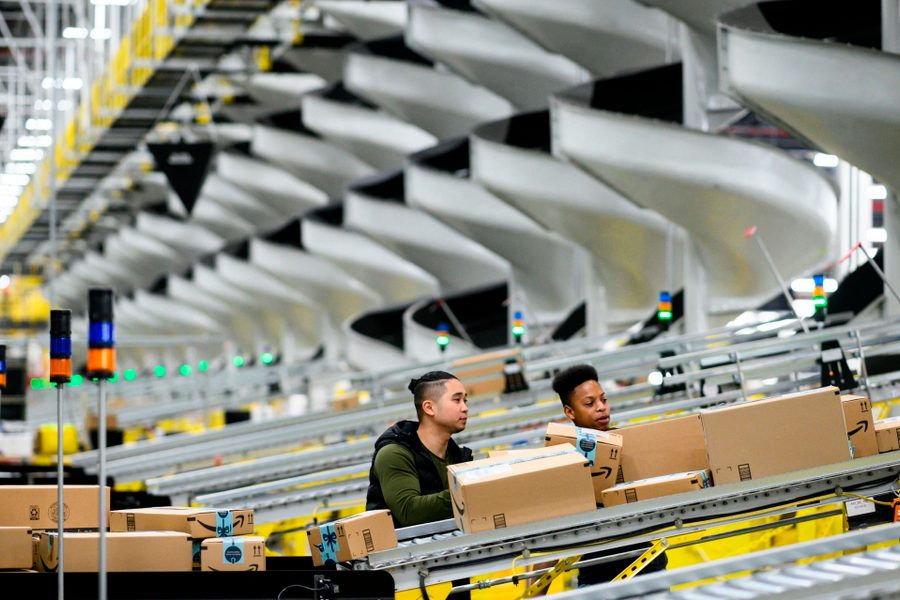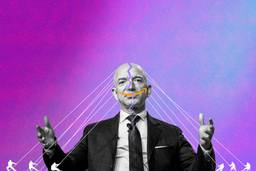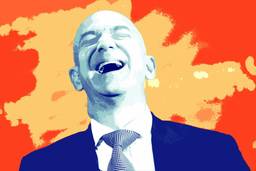Is Amazon Violating U.S. Antitrust Laws? This Law Student Thinks He Has Evidence.
Amazon’s reports of low--or zero--profits have long raised suspicions that it’s selling below cost to build a global monopoly.
David Dayen

Amazon famously barely turned a profit in its first twenty years, and even today nearly all of its operating income comes from cloud-computing service Amazon Web Services. To hear CEO Jeff Bezos tell it, Amazon focuses relentlessly on customer needs, serving as a kind of charity run for the benefit of its users.
Many critics have offered a more sinister theory: Amazon has spent the past couple decades building up market share by underpricing competitors, and someday, when there are no alternatives left, it will become fabulously profitable. Amazon is laying in wait, in other words, to become a monopoly.
The technical term for this is predatory pricing, and it’s actually illegal under U.S. antitrust laws. You can’t drop prices with the intent to monopolize. But predatory pricing is extremely difficult to prove in court. Plaintiffs bringing suit would have to demonstrate that Amazon set prices below the cost of production, which is difficult without access to the internal books. In addition, plaintiffs would have to establish that Amazon’s practices had a high likelihood of successfully creating a lucrative monopoly.
The high bar is thanks to Robert Bork, the godfather of modern antitrust theory, who declared predatory pricing schemes irrational in his influential book The Antitrust Paradox. The Supreme Court adopted Bork’s theory in a 1986 case, claiming that it would be “implausible” for Japanese electronics makers to conspire to hold prices low for television sets exported to the U.S. This would “require the conspirators to sustain substantial losses in order to recover uncertain gains,” the Court ruled. Since then, predatory pricing cases have been few and far between.
But Shaoul Sussman, a law student at Fordham University, thinks he’s come up with a roadmap to prove that Amazon profitably engages in predatory pricing, overcoming Bork’s skepticism. In a paper for the Journal of Antitrust Enforcement published in February that has generated discussion in academic circles, Sussman points to evidence that Amazon has already flipped the switch, moving from dominating the market by undercutting rivals to reaping the profits from that dominance. And Amazon’s doing it, Sussman claims, without raising prices for customers. This strategy is even more attractive because corporate accounting rules make the conduct virtually undetectable.
If Sussman is right, Amazon’s suppliers could use his theories to sue the company and gather evidence in discovery that could reveal illegal maneuvering. The paper could also spur the Federal Trade Commission to make a simple rule change that would lay bare Amazon’s practices. And, it could blow up a scheme that Uber, Lime, and numerous other startups have been accused of undertaking.
Here’s how it works.
HIDING EXPENSES
Amazon routinely highlights its cash flow instead of earnings, signaling to investors that it’s on a road to profitability. The cash flow number zoomed to over $30 billion in 2018. Positive cash flow is often used as evidence against predatory pricing; if Amazon has negative cash flow, it could be subsidizing an anti-competitive scheme to edge out rivals.
However, Sussman asserts in his paper, “Amazon utilizes existing loopholes in Generally Accepted Accounting Principles (GAAP) disclosure regulations to exclude a significant portion of its expenses.”
Amazon accomplishes this in part through using capital leases to purchase equipment and some of its 288 million square feet of office space. Instead of paying cash, Amazon borrows and finances these purchases over time. The leases don’t show up as expenses in Amazon’s free cash flow calculations, even though the equipment is listed as an asset. A 2017 Motley Fool report showed that, when you add in capital leases, Amazon’s 2017 cash flow was indeed over $1 billion in the red, although more recent numbers have bounced back.
The point, Sussman tells In These Times, is that Amazon “can move numbers on balance sheets from one side to the other to obscure the numbers on cash flows.” Amazon has chronically resisted attempts to reveal the inner workings of its financial structure. Sussman believes that if Amazon gave the full picture, it would show negative cash flow.
No current accounting rules force full disclosure of itemized costs. Considered highly confidential, they’re typically redacted from public legal documents, even when a company is sued. More definitive cash flow numbers could help prove whether Amazon sells items below cost.
But proving that Amazon sells below cost is only half the battle.
HOW AMAZON RECOUPS ITS LOSSES
By now, Amazon has established its dominance, supplying 45 percent of all e-commerce purchases and boasting the second-largest paid digital membership program behind Netflix, with 100 million Amazon Prime users. We already know that Amazon’s low prices, which it achieved both by avoiding sales tax for years and severely undercutting rivals, played a major role in gaining customers.
But the second step to proving predatory pricing involves laying out how companies can profit from the monopoly they set out to build, by making back losses incurred from selling below cost. Sussman’s real insight concerns how Amazon has the ability to surge profits without relinquishing its brand-defining commitment to low prices. The losers in this scheme the suppliers and partners, who have virtually no other way to sell their wares.
Amazon doesn’t only sell its own products, or products it acquires from wholesalers. Third-party sellers make up 58 percent of all sales on the Amazon marketplace, according to Jeff Bezos’ most recent annual letter to shareholders. These sellers pay fees to Amazon for the privilege of setting up shop on the website. Sellers can use “Fulfillment by Amazon,” so Amazon handles storage and shipping of its products through its vast logistics network. But Amazon also charges for that privilege.
These fees happen to be among the fastest-growing revenues on Amazon’s balance sheet. In the fourth quarter of 2018, revenue from third-party sellers, including marketplace and fulfillment fees, totaled $13.4 billion, or one in every five dollars Amazon earned in the quarter.
Profit margins on marketplace fees are high: Around 20 percent, according to one Morgan Stanley estimate, as opposed to just a 5 percent profit margin on Amazon’s own retail sales. It’s simply more attractive financially for Amazon to run the marketplace than to sell their own products.
There’s nothing illegal about any of this. But in March, Bloomberg reported that Amazon had abruptly stopped buying directly from thousands of wholesalers, encouraging them to instead convert into third-party sellers. As the Bloomberg article notes, this not only offloads Amazon’s costs of storing and shipping products onto wholesalers, it also allows Amazon to collect more marketplace fees.
That’s a red flag. It could mean that Amazon knowingly sold items at a loss during its early history, and is now reducing costs on the same sales, while also taking a bite out of suppliers’ profits through marketplace fees. That’s the textbook definition of a predatory pricing scheme.
Amazon’s dominance makes this all work. Wholesalers who want to sell online don’t have many options beyond agreeing to the demands of the dominant e-commerce leader. Instagram recently launched an in-app shopping tool, but Amazon has such a head start that everyone has to sell there. And as the company continues to grow, it can force even large wholesalers into this arrangement, without fear of losing their business.
“The reason they lured everyone onto the platform is they were subsidizing activity,” Sussman explains. “Whatever costs with shipping and deliveries, Amazon said we’re going to take care of them. But suppliers now have to incur those costs.”
Couldn’t third-party sellers just raise prices in response? Until recently, no. Amazon had a clause in its contracts preventing sellers from offering a lower price on other websites. Last month the company revoked that clause after Sen. Richard Blumenthal (D-Conn.) warned that it risked an antitrust violation. But Amazon still has numerous methods that it can use to prevent third-party sellers from passing costs on to customers.
For instance, Amazon can theoretically down-rate higher-priced sellers in search listings, a primary way most customers interact with the website. A seller on page three of Amazon search might as well not be selling on the site at all; nobody is likely to see them. “The price has to stay the same because they’re disciplined on Amazon,” Sussman suggests.
Amazon has also begun to effectively force sellers to lower costs if they want to advertise on the website. Only brands Amazon can sell at a profit get advertising privileges: This is part of a strategy to push out “CRaP” products, short for “Can’t Realize a Profit.” The rule only affects direct vendors, which is another way Amazon can pressure business partners to convert to third-party sellers.
But think about it. Just the fact that Amazon had an entire group of “Can’t Realize a Profit” products for sale strongly suggests that it sold items below cost. Now that the company is more interested in profitability, it wants to lower costs on CRaP items. Again, that’s precisely what a predatory pricing scheme looks like: Sell below cost, become dominant, and leverage that dominance to profit.
Advertising is another way Amazon can make money without customers feeling it. Ad revenue doubled to $10.1 billion in 2018. So as an Amazon supplier, your costs continually go up for fees and advertising, but you cannot raise prices to compensate. Amazon instead scoops up the excess revenue, like a more sophisticated version of a landlord in the earth’s biggest mall. “It’s a transfer to Amazon from suppliers,” says Peter Carstensen, a professor emeritus at the University of Wisconsin Law School.
HOW CUSTOMERS ARE HARMED
As Sussman explains, if Amazon is recouping losses from a predatory pricing scheme by reducing its costs, the windfall profits aren’t being transferred to customers. In addition, a supplier to Amazon is hindered from improving its products, because Amazon is skimming profits off the top that could be put toward innovation.
Both of these outcomes reflect consumers failing to share in Amazon’s bounty, which is key for current antitrust law. Right now, anti-competitive conduct like predatory pricing is judged under the “consumer welfare standard,” which has been interpreted to mean simply whether a market dominated by a single company results in higher or lower prices. But even though prices are the same on Amazon, consumers are arguably missing out, Sussman explains, because they’re not benefiting from Amazon’s soaring profits. “It’s illegal and even the most conservative neoclassical thinker would agree,” he says.
Sussman constructed his theory as something a company harmed by Amazon could use to file a lawsuit, even if no antitrust laws are changed. If it survives an initial motion to dismiss in the courts, Amazon would have to reveal unit costs in a discovery proceeding, which would settle the controversy.
The concept has reformers who want to strengthen antitrust laws buzzing. “It’s long overdue for a rethinking of predatory pricing,” says Matt Stoller of the Open Markets Institute, the leading pro-reform organization.
Sussman believes that the Federal Trade Commission should force companies to break down their costs in confidential examinations, so regulators could get a better picture of potential predatory pricing, which many fear has become a feature of modern-day “unicorns.”
Rideshare companies like Uber and Lyft, e-scooter firms like Bird and Lime, and co-working space provider WeWork have all been accused of undercutting rivals in an effort to monopolize markets. If anyone takes up such a case against Amazon, it could reveal how predatory pricing has become a dedicated business strategy in New Gilded Age America, and how regulators can put a stop to it.







